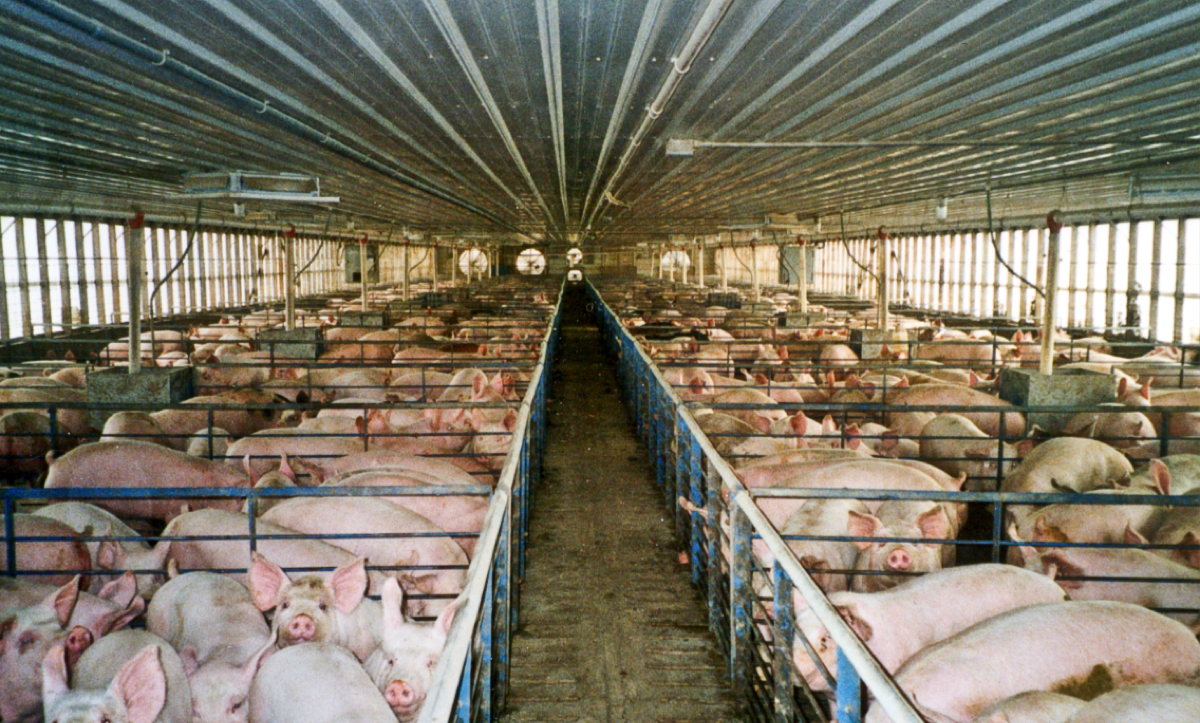Don’t get me wrong, I enjoy eating a big juicy steak as much as the next person. But you’ve got to wonder: How was this animal raised? Where does its waste go as it is creating that delicious steak? What impact does it have on the environment? Can we improve the “system”?

Concentrated Animal Feeding Operation
A recent Science Friday episode, “Tales from ‘Big Pig’,” discussed a new book by Barry Estabrook, titled, “Pig Tales: An Omnivore’s Quest for Sustainable Meat.” In it he discusses the environmental and social impacts of raising animals on concentrated animal feeding operations (CAFOs) for mass meat consumption. Included in the discussion are the differences in the regulations for treating animal waste versus human waste. He pointed out that there are little to no regulations requiring animal farmers to treat wastewater runoff from their farms.
According to the USEPA, CAFOs fall under the National Pollutant Discharge Elimination System (NPDES) Permit Regulations for discharge of pollutants from point sources to waters. NPDES permits require CAFOs to have treatment lagoon capacity designed for the facility’s drainage area from a 25-year, 24-hour rainfall event and clean water drainage systems that divert clean water away from the production facility. The treatment lagoons are similar to rural wastewater treatment facilities where solids settle to the bottom and nutrients (such as nitrogen and phosphorus) are removed from the water by bacteria and green algae.
So great we are all covered!…Well, maybe not. The NPDES permit regulations only apply to CAFOs who wish to discharge their liquid waste to external water bodies. Permits may not be required if the liquid manure is applied to non-agricultural lands or the water is not discharged directly to a river.
In addition to the nutrient pollution that comes naturally, all animals on CAFOs are kept on a regiment of antibiotics, hormones, and steroids that are lumped together in a category called pharmaceuticals and personal care products (PPCPs). Both animal and human bodies typically only use a fraction of the concentration of the PPCPs administered which means the rest is excreted through waste.
The treatment lagoons, as is similar to wastewater treatment plants, were never designed to reduce PPCP loads in their effluent or solids, though some PPCPs do get removed during treatment. But many do not and, thus, these can have untold impacts on the environment and wildlife, even at very small concentrations (parts per trillion). If the manure is land-applied, could the vegetation take up the PPCPs and dose animals or possibly humans when consumed?
All is not lost, however. An ISTC researcher, Wei Zheng, and his team are investigating the environmental impacts of CAFOs and hope to invent a low-cost easy way to treat wastewater for PPCPs.
What can I do to make a difference?
Don’t flush your unwanted medications down the toilet or throw them in the trash. Properly dispose of them through a local take-back program.
The cities of Champaign and Urbana have started an unwanted medications collection mission through efforts of the Illinois-Indiana Sea Grant at the University of Illinois at Urbana-Champaign, with sponsorship by ISTC, the cities of Champaign and Urbana and Illinois American Water as well as other partners and local police stations. There are drop boxes located in the lobbies of the Champaign, Urbana, Champaign County, and University of Illinois Police Departments where you can drop off your unwanted prescription and over-the-counter drugs, including any leftover vitamins, supplements, and veterinary pharmaceuticals. The boxes are available 24 hours a day. Periodically the police coordinate secure deliveries of the collected medications to an incineration facility in Indiana.
If you don’t live in the Champaign-Urbana area, check with your city’s sustainability officer or police department or your local pharmacy to see if they have a PPCP collection program. If they don’t, you could lead the effort to get one started.

Example of medicine drop box in the lobby of the Champaign Police Department
How can I learn more about the collection program or the research?
- Discover more about ISTC’s PPCP research by visiting our website.
- ISTC and the Illinois-Indian Sea Grant (IISG) will be at the Illinois State Fair in the Fisheries Tent in Conservation World August 14-21, 2015.
- ISTC and IISG will also be at Urbana’s Market at the Square in the Community Group section on Saturday, September 12 to discuss their work on PPCPs and the medication collection program.
- You can contact Laura Kammin (IISG) for more information about the medicine collection program and starting one in your community.

